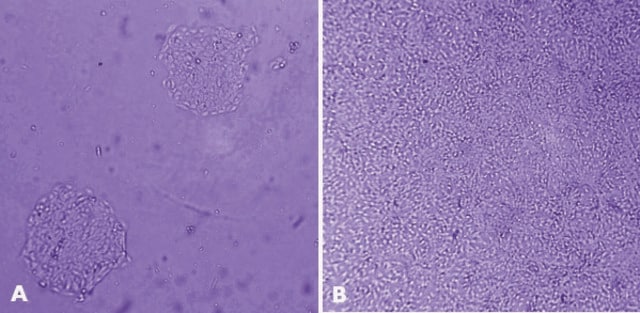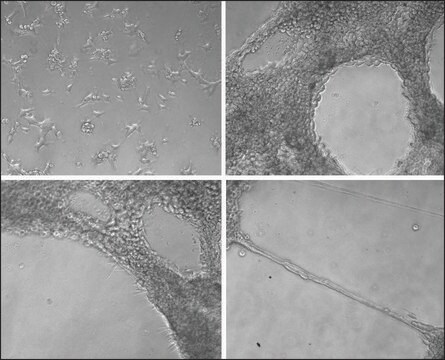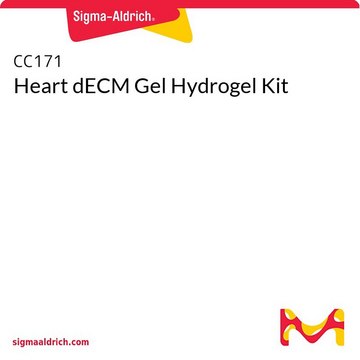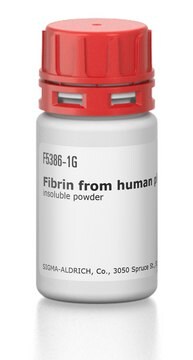HYSC010
HyStem®-C Cell Culture Scaffold Kit
Trial Kit, For 2.5 mL of hydrogel scaffold solution
About This Item
Recommended Products
Quality Level
storage temp.
−20°C
Looking for similar products? Visit Product Comparison Guide
Application
Features and Benefits
- Customizable - each distinct cell type in a multicellular organism has its own unique microenvironment. Hystem-C offers the flexibility to tailor the environments of cultured cells to mimic their in vivo counterparts and optimize proliferation and differentiation.
- Synthetic - As a synthetic matrix, Hystem-C offers greater control of the cellular environment than ambiguous extracted ECM alternatives. All components are well characterized and consistently formulated. Hystem-C contains Hyaluronic acid (synthetic), Extralink (synthetic), Gelin-S (porcine), and Water.
- Biologically accurate - Rich in hyaluronic acid and denatured collagen, the Hystem-C hydrogel closely mimics the complex three dimensional cellular environments found in life, providing an optimal environment for culturing your cells.
Hystem-C enables the attachment of a wide variety of cell types through Gelin-S (thiolated gelatin).
The Hystem-C Trial Kit enables researchers to evaluate the Hystem-C technology in their own hands and confirm that Hystem-C is the right choice for their research.
With Hystem-C, researchers can tailor the incorporation of ECM proteins and growth factors as well as the elasticity of the hydrogel and cell incorporation (encapsulations or top plating) to create the specific 3D environment required by their cells.
Hystem-C has been successfully used to expand human embryonic stem cells, human mesenchymal stem cells, neural progenitor cells, and hepatic progenitor cells.
- Customizable - each distinct cell type in a multicellular organism has its own unique microenvironment. Hystem-C offers the flexibility to tailor the environments of cultured cells to mimic their in vivo counterparts and optimize proliferation and differentiation.
- Synthetic - As a synthetic matrix, Hystem-C offers greater control of the cellular environment than ambiguous extracted ECM alternatives. All components are well characterized and consistently formulated. Hystem-C contains Hyaluronic acid (synthetic), Extralink (synthetic), Gelin-S (porcine), and Water.
- Biologically accurate - Rich in hyaluronic acid and denatured collagen, the Hystem-C hydrogel closely mimics the complex three dimensional cellular environments found in life, providing an optimal environment for culturing your cells.
Legal Information
related product
Signal Word
Danger
Hazard Statements
Precautionary Statements
Hazard Classifications
Eye Dam. 1 - Skin Irrit. 2 - Skin Sens. 1
Storage Class Code
10 - Combustible liquids
Certificates of Analysis (COA)
Search for Certificates of Analysis (COA) by entering the products Lot/Batch Number. Lot and Batch Numbers can be found on a product’s label following the words ‘Lot’ or ‘Batch’.
Already Own This Product?
Find documentation for the products that you have recently purchased in the Document Library.
Articles
Cell delivery vehicle are components that can be associated with cells and that allow transplantation in human or animals hosts. These can be natural or synthetic components that will form a gel, embedding the cells.
Hyaluronan is a major component of the extracellular matrix. It’s the simplest glycosaminoglycan, and it plays several biological roles.
Heparin is distinct from heparan sulfate proteoglycans (HS) which is primarily produced by mast cells. While, HS is produced by all cell types. Know more about the difference between heparin and heparin sulfate proteoglycan and select the right component for your study.
Hystem 3D hydrogels are based on hyaluronic acid, a major component of the extracellular matrix. 3D cell culture can be done using Hystem hydrogels.
Our team of scientists has experience in all areas of research including Life Science, Material Science, Chemical Synthesis, Chromatography, Analytical and many others.
Contact Technical Service






